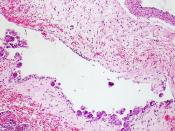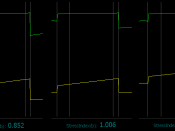Adult (acute) respiratory distress syndrome (ARDS) is the rapid onset of progressive malfunction of the lungs, especially with regard to the ability to take in oxygen, usually associated with the malfunction of other organs. The condition is associated with extensive pulmonary inflammation and small blood vessel injury in all affected organs. ARDS has a fatality rate of approximately 50 despite supportive therapy, including assisted respiration. It is difficult to estimate the incidence of ARDS because it is often associated with other severe illnesses. But it is a common problem in hospital intensive care units. The incidence of ARDS has been difficult to determine, due partly to the variety of causes. Various published estimates have ranged from 1.5 to 71 cases per 100,000 population. Other figures suggest the occurrence of 13,000 to 27,000 cases annually.
Pathophysiology ARDS is the end result of acute alveolar injury caused by a variety of insults and probably initiated by different mechanisms.
The initial injury is to either the capillary endothelium or alveolar epithelium. There is increased capillary permeability, Organization and scarring follows. The capillary defect is produced by an interaction of inflammatory cells and mediators, including leukocytes, cytokines, oxygen radicals, complement and arachidonate metabolites, that damages the endothelium and allows fluid and proteins to leak. Endotoxin, neutrophils and macrophages may also play key roles in the pathogenesis of ARDS. ARDS results from widespread acute injury to the alveolar capillary membrane. This produces high permeability edema, visible on the chest x-ray. It also inhibits surfactant function (especially fibrin monomers). Epithelial injury also impairs new surfactant synthesis. Inflammation may exacerbate the injury because of release of oxidants and lysosomal enzymes from activated leukocytes. Lung compliance (delta V) / (delta P) is decreased because many airspace's contain edema (and hence cannot accept air) and because abnormally high surface...


